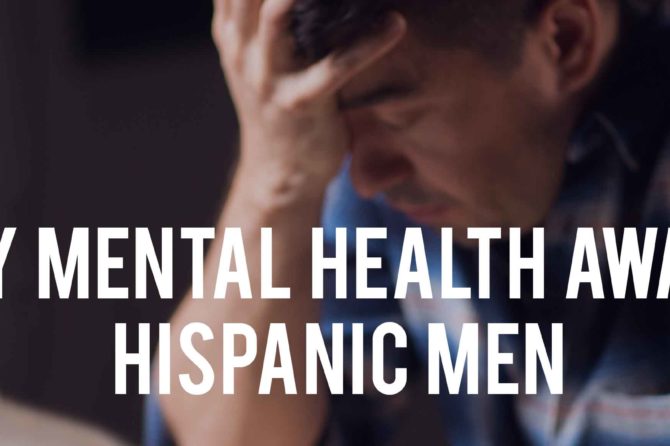
Minority Mental Health Awareness: Hispanic Males and Addiction Recovery
Hispanics are a growing minority in the United States. According to the US Census Bureau:
- By 2060, the number of Hispanics in the United States is projected to grow to 129 million, or 31 percent of the population. Of all of the nations of the world, only Mexico has a larger Hispanic population than the United States.
- 65 percent of U.S. Hispanics have a Mexican background, followed by 9.4 percent with a Puerto Rican background, 3.8 percent with a Salvadoran background, 3.6 percent with a Cuban background, 3 percent with a Dominican background, and 2.3 percent with a Guatemalan background.
- Latinos are highly concentrated in a few states in the U.S., including Texas, California, and New Mexico. 47 percent of New Mexico’s population is Hispanic. Hispanics also constitute significant percentages of the population in states such as Arizona, Colorado, and Washington. Also, more than one million Hispanics live in Florida, Illinois, New York, and New Jersey.
- Hispanics owned 8.3 percent of U.S. firms in 2008.
- Overall, 63 percent of Latinos have graduated from high school and 13 percent have graduated from college.
- Twenty-five percent of Hispanics live in poverty.
- There are 1.2 million Hispanic armed forces veterans in the U.S.
According to an article in the US National Library of Medicine/National Institutes of Health entitled “Prevalence of Mental Illness in Immigrant and Non-Immigrant U.S. Latino Groups”
- Lifetime prevalence rates are more than 50 percent for non-Latino whites born in the US, versus between 30 and 40 percent for Latino populations born in the US.
- Among US-born Latinos, Mexican Americans and Puerto Ricans have comparable lifetime prevalence rates, around 40 percent, while Cuban Americans and other Latinos have lifetime prevalence rates closer to 30 percent.
- Among immigrants, Cuban Americans, Mexican Americans, and other Latinos all have lifetime prevalence rates below 30 percent.
However, despite these overall lower rates, a CDC report states:
- Latino high school males are just as likely to report suicidal thinking as non-Latino whites (10.7 percent versus 10.5 percent), and more likely to attempt suicide (6.9 percent versus 4.6 percent).
- Latino high school females are more likely to report suicidal thinking than non-Latino white females (20.2 percent to 16.1 percent), and more likely to attempt suicide as well (13.5 percent to 7.9 percent).
- As the CDC data suggest, young Latino females are nearly twice as likely as males both to think about suicide and to attempt suicide.
A report by the National Survey on Drug Use and Health (NSDUH) says that combined 2003 to 2011 data indicate that Hispanics were more likely than non-Hispanics to have needed treatment in the past year. That is, 9.9 percent of Hispanics (3.4 million) and 9.2 percent of non-Hispanics (19.7 million) needed substance use treatment. Among persons aged 12 or older who were in need of treatment, Hispanics were less likely than non-Hispanics to have received treatment (9.0 vs. 10.5 percent). An estimated 3.1 million Hispanics needed but did not receive specialty treatment.
Among Hispanics who needed but did not receive treatment in the past year, 94.4 percent did not feel the need for it, 3.6 percent felt the need for treatment but did not make an effort to get it, and 2.0 percent felt the need for treatment and did make an effort to get it. Similarly, among non-Hispanics in need of but not receiving treatment, 94.8 percent did not feel the need for treatment, 3.5 percent felt the need for treatment but did not make an effort to get it, and 1.7 percent felt the need for treatment and did make an effort to get it.
The National Comorbidity Study found that relative to whites, Mexican Americans had fewer lifetime disorders overall and less anxiety and substance use disorders.
Indeed, Mexican Americans born outside the United States were found to have lower prevalence rates of any lifetime disorders than Mexican Americans born in the United States. Relative to whites, the lifetime prevalence rates did not differ for Puerto Ricans or for “Other Hispanics.”
Another study found that the lifetime rates of mental disorders among Mexican American immigrants born in Mexico were remarkably lower than the rates of mental disorders among Mexican Americans born in the United States. Overall, approximately 25 percent of the Mexican immigrants had some disorder (including both mental disorders and substance abuse), whereas 48 percent of the U.S.-born Mexican Americans had a disorder
Unfortunately, stigmas about mental health and seeking or receiving help for illness and addictions remain strong in the Hispanic communities. It’s not unique to those communities either; less than one-third of the estimated 18 million American adults who have mental illness seek out or receive treatment for it. A study by William Bega, Ph.D., and professor at the University of Southern California, that surveyed 200 depressed and low-income Latinos in Los Angeles suggested that over half of the participants thought that depressed people weren’t “trustworthy” and that they were unwilling to hang out with a person who is depressed. Participants who self-stigmatized were found to be less likely to take medication or maintain previously scheduled appointments with their doctors.
If you or a loved one is suffering from any form of mental illness, especially those that lead to addiction issues, we urge you to seek out help before the situation worsens. There should be no stigmas attached to getting better, feeling refreshed and rejuvenated, and once again becoming a contributing member of the family.
Leave a reply